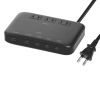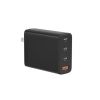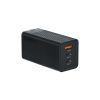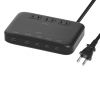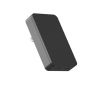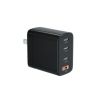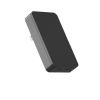Gallium Nitride (GaN) charger, we need to know about it!
I. What is Gallium Nitride (GaN)?
Gallium Nitride (GaN) is a compound of nitrogen and gallium, representing a direct bandgap semiconductor. It is a wide-bandgap semiconductor material with a stable hexagonal crystal structure. Its characteristics include high power efficiency, low losses, high frequency capabilities, and resistance to high temperature and voltage. When applied in chargers, GaN significantly improves charging efficiency while enhancing safety.
Moreover, GaN chargers with an output power exceeding 50W and featuring multiple interfaces leverage these advantages to the fullest, albeit at a relatively higher cost.
| Classification and characteristics of gallium nitride chargers | ||
| Classification Basis | Subcategories | Product Features |
| By Output Power | Output Power ≤ 50W | Low power, slow charging speed, affordable, usually single interface for phone charging |
| 50 < Output Power ≤ 100W | 50 < Output Power ≤ 100W | Fast charging speed, higher cost, multiple interfaces, can charge both phones and computers simultaneously | |
| Output Power > 100W | High power, fast charging speed, expensive, larger size, heavier weight | |
| By Interface Quantity | Multiple Interfaces | Multiple Interfaces | High power, fast charging speed, expensive, larger size, heavier weight |
| Single Interface | Lower power, slow charging speed, affordable, smaller size, lighter weight | |
2.Differences Between Gallium Nitride (GaN) Chargers and Regular Chargers
GaN is a compound of nitrogen and gallium, representing a direct bandgap semiconductor. It is a third-generation semiconductor material with high thermal conductivity and excellent chemical stability. In contrast, regular chargers are typically based on silicon. When compared to silicon, GaN semiconductor material has lower losses, reducing heating caused by lower resistance. This, in turn, allows for a reduction in the volume of transformers and capacitors. Therefore, GaN chargers have higher charging power than regular chargers, while maintaining a smaller form factor. Of course, the cost of GaN chargers is also higher than that of regular chargers.
Traditional charger switch tubes are basically made of silicon and germanium semiconductor materials. Faced with the "big appetite" of today's portable devices, the frequency of this type of switch tube is already very high, almost reaching the limit of physical materials, and the charging efficiency and There is little room for improvement in charging power. Further increasing the frequency will not only greatly increase the difficulty of the process, but also bring greater switching losses, increase heat generation, and reduce efficiency. Therefore, silicon semiconductors have reached a bottleneck.
Gallium nitride is a new semiconductor material that can replace silicon and germanium. The switching frequency of gallium nitride switch tubes made of it is greatly increased, the loss is smaller, and it has super thermal conductivity efficiency. In this way, the gallium nitride charger can effectively optimize the size of the transformer and capacitor, thereby effectively reducing the size of the charger, reducing heat generation, improving efficiency, and meeting the needs of multi-purpose appliances for fast charging. The most obvious difference is that gallium nitride chargers can easily achieve tens or even hundreds of watts of charging power, and basically have multiple capabilities.
3.How should we choose a gallium nitride charger?
When choosing a Gallium Nitride (GaN) charger, first confirm the built-in number of ports. While a charger with a single port can charge only one device at a time, its simple construction not only effectively reduces the size but also avoids power sharing with other devices, significantly improving charging speed. On the other hand, chargers with multiple ports allow you to connect multiple devices simultaneously. However, the benefits are subject to the charger's performance, and it may not provide full power output to each device.
Inquire
By continuing to use the site you agree to our privacy policy Terms and Conditions.


